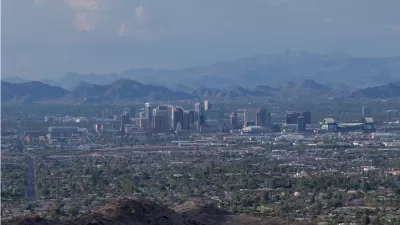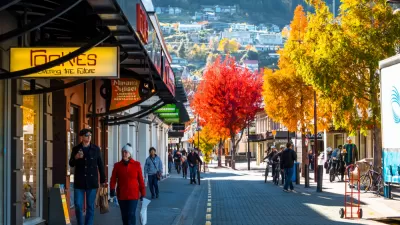Whether or not the suburban shift accelerated by the pandemic continues, policymakers can implement climate resilience strategies and guide sustainable growth in both cities and exurbs.

As Joseph Kane, Mona Tong, and Jenny Schuetz write, historically, a few key factors dictate where people choose to live: “proximity to where they work, preferred amenities like school quality or climate, and connections to social networks of family and friends.”
In the last two years, “According to prevailing media narratives, the pandemic has ‘supercharged’ suburbanization rates and even hastened the death of U.S. cities.” In fact, the authors argue, “this largely continues pre-pandemic trends. Between July 1, 2020 and July 1, 2021, many core urban counties (those home to the largest city within a metro area) continued to experience greater population losses than their neighboring suburban counties.”
Regional leaders, the authors argue, should avoid kneejerk reactions and “take a step back and recognize the uncertainty and complexity surrounding them—including the need to better analyze and assess their region’s evolving concerns.”
Whether the reaction to the pandemic is a short-term blip or longer-term pattern, it has not reduced our collective need for greater resilience—supporting our ability to live in safe, affordable, and climate-friendly communities. That means having smaller, more affordable housing, which allows workers at all income levels to live close to jobs and amenities.
The authors conclude that “In light of these unknowns, post-pandemic planning should focus on baking in more flexibility and best practices into our land use plans to prepare us for both potential future spikes in housing demand and the general long-term trend of increasing suburban and exurban population growth.”
FULL STORY: Pandemic-fueled suburban growth doesn’t mean we should abandon climate resiliency

Maui's Vacation Rental Debate Turns Ugly
Verbal attacks, misinformation campaigns and fistfights plague a high-stakes debate to convert thousands of vacation rentals into long-term housing.

Planetizen Federal Action Tracker
A weekly monitor of how Trump’s orders and actions are impacting planners and planning in America.

In Urban Planning, AI Prompting Could be the New Design Thinking
Creativity has long been key to great urban design. What if we see AI as our new creative partner?

How Trump's HUD Budget Proposal Would Harm Homelessness Response
Experts say the change to the HUD budget would make it more difficult to identify people who are homeless and connect them with services, and to prevent homelessness.

The Vast Potential of the Right-of-Way
One writer argues that the space between two building faces is the most important element of the built environment.

Florida Seniors Face Rising Homelessness Risk
High housing costs are pushing more seniors, many of them on a fixed income, into homelessness.
Urban Design for Planners 1: Software Tools
This six-course series explores essential urban design concepts using open source software and equips planners with the tools they need to participate fully in the urban design process.
Planning for Universal Design
Learn the tools for implementing Universal Design in planning regulations.
Gallatin County Department of Planning & Community Development
Heyer Gruel & Associates PA
JM Goldson LLC
City of Camden Redevelopment Agency
City of Astoria
Transportation Research & Education Center (TREC) at Portland State University
Jefferson Parish Government
Camden Redevelopment Agency
City of Claremont





























